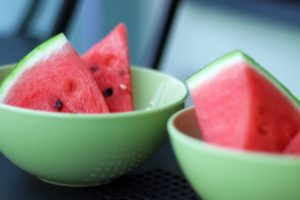Dehydration in the elderly
Fluid intake in the elderly is important, and particularly in these warmer, summer months. According to the British Nutrition Foundation (BNF), older people are vulnerable to dehydration due to physiological changes in the ageing process, but this can be complicated by many disease states, and mental and physical frailty that can further increase risk of dehydration.
Symptoms of dehydration:
 – Reduced urine output and passing concentrated urine (although it’s important to consider other factors which could also impact the colour of urine).
– Reduced urine output and passing concentrated urine (although it’s important to consider other factors which could also impact the colour of urine).
– Dry mouth/lips
– Confusion
– Low blood pressure
– Dizziness
The above symptoms can contribute towards further issues, such as constipation and increased risk of falls from dizziness.
Tips to increase fluid intake:
– Offer foods with high water content. Around a fifth of our daily fluid intake comes from the foods we eat. You can  encourage good fluid intake by offering your patients snacks which have a high water content. This includes cucumber, tomatoes, melon and oranges, to name a few.
encourage good fluid intake by offering your patients snacks which have a high water content. This includes cucumber, tomatoes, melon and oranges, to name a few.
– Provide a choice of beverages. Not everyone likes water, and some people aren’t tea or coffee drinkers. By offering your patients a wider choice of beverages, you can increase the likelihood of them picking something they fancy and are likely to drink more of.
– Ensure drinks are constantly available and replenished frequently. Some ice cubes or a slice of lemon can go a long way to making a jug of water seem more appetising (British Nutrition Foundation, 2018)
– Fluid balance chart. When caring for multiple patients (as you often will be), it can be hard on a shift to keep track of exactly how much your patients have had to drink. If there’s a patient who you feel isn’t drinking as much as they ought to, keeping a fluid balance chart can be useful to keep a record of their intake.
– Provide physical assistance with drinking to patients who need it. Not everyone will have the strength or dexterity to drink independently. Therefore, it’s important assistance is provided. For patients with a tremor or who are at risk of spillage, a beaker can be offered as an alternative receptacle.
– For patients at risk of dysphagia, thickener should be added to drinks to decrease the risk of aspiration and respiratory distress when drinking.
Fluid intake and incontinence
Some elderly people worry about incontinence and can intentionally restrict their fluid intake as a result. For these individuals, it can be useful to show them how regulating their fluid intake throughout the day can help to reduce the risk of accidents. For example, increasing fluid intake at the start of the day and decreasing intake towards night time. This can also help with nocturia, which is known to be more common in the elderly. Encouraging elderly patients to build regular toilet visits into their day may also help reduce worrying about incontinence, particularly if their fluid intake is higher (for example, due to warmer weather).


